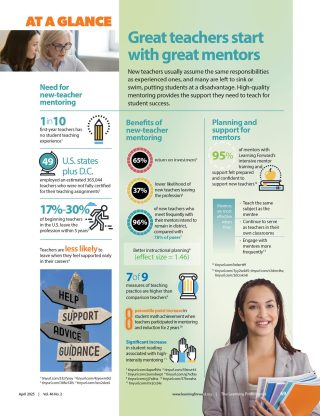Read the remaining content with membership access. Join or log in below to continue.
Sed ut perspiciatis unde omnis iste natus error sit voluptatem accusantium doloremque laudantium, totam rem aperiam, eaque ipsa quae ab illo inventore veritatis et quasi architecto beatae vitae dicta sunt explicabo. Nemo enim ipsam voluptatem quia voluptas sit aspernatur aut odit aut fugit, sed quia consequuntur magni dolores eos qui ratione voluptatem sequi nesciunt. Neque porro quisquam est, qui dolorem ipsum quia dolor sit amet, consectetur, adipisci velit, sed quia non numquam eius modi tempora incidunt ut labore et dolore magnam aliquam quaerat voluptatem.
References
American Federation of Teachers. (2017). 2017 educator quality of work life survey. Author.
Berkovich, I. & Eyal, O. (2021). A model of emotional leadership in schools: Effective leadership to support teachers’ emotions. Routledge.
Carver-Thomas, D. & Darling-Hammond, L. (2017). Teacher turnover: Why it matters and what we can do about it. Learning Policy Institute.
Knoblach, S. (2019). Employee engagement benchmarking study. K12 Insight. www.k12insight.com/resources/#benchmark
Knoblach, S. (2019). Employee engagement benchmarking study. K12 Insight. www.k12insight.com/resources/#benchmark
Lawrence, D.F., Loi, N.M., & Gudex, B.W. (2019). Understanding the relationship between work intensification and burnout in secondary teachers. Teachers and Teaching, 25(2), 189-199.
Leithwood, K. & Beatty, B. (2009). Leading with teacher emotions in mind. Corwin Press.
Leithwood, K., Anderson, S.F., Mascall, B., & Strauss, T. (n.d.). School leaders’ influences on student learning: The four paths. www.leadershippartnerstx.com/files/1_school_leaders_influence_4_paths_to_learning.pdf
Wang, H., Hall, N.C., & Taxer, J.L. (2019). Antecedents and consequences of teachers’ emotional labor: A systematic review and meta-analytic investigation. Educational Psychology Review, 31, 663-698.

James A. Bailey (james@sel-leaderu.com) and Randy Weiner (randy@sel-leaderu.com) are partners at SEL-LeaderU.

Randy Weiner (randy@sel-leaderu.com) are partners at SEL-LeaderU.
Recent Issues
BUILDING BRIDGES
December 2024
Students benefit when educators bridge the continuum of professional...
CURRICULUM-BASED PROFESSIONAL LEARNING
October 2024
High-quality curriculum requires skilled educators to put it into...
LEARNING TO PIVOT
August 2024
Sometimes new information and situations call for major change. This issue...
GLOBAL PERSPECTIVES
June 2024
What does professional learning look like around the world? This issue...












